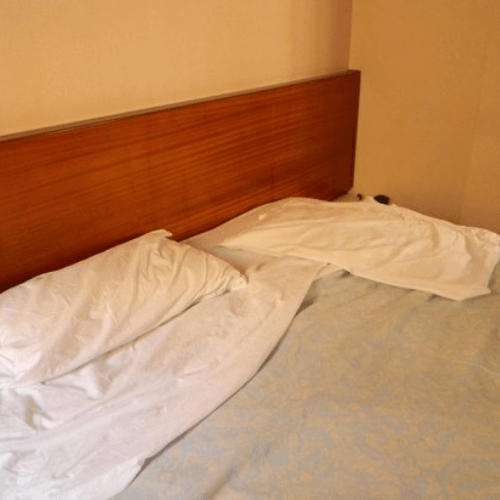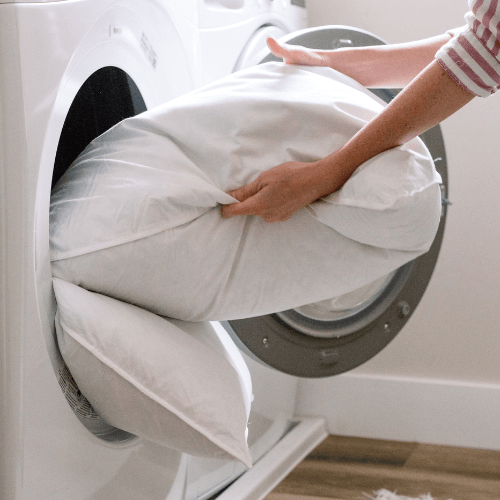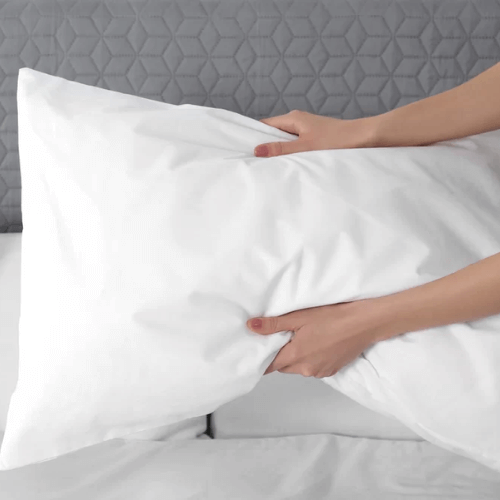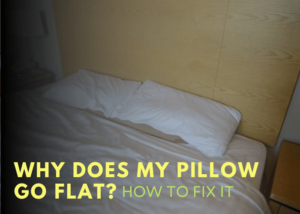Pillows get flat quickly, and it’s frustrating. Nothing’s worse than lying down on a pillow that has lost its shape. People want to know why their pillows go flat and how to fix them.
We will explain both.
It’s important to understand why pillows flatten and how to prevent it from happening again.
Flattened pillows aren’t just uncomfortable – they also pose health risks due to poor neck support.
Knowing the causes of flattened pillows and how to fix them is essential for maintaining healthy sleep habits.
This article will help readers understand why their pillows go flat and what they can do to keep them fluffy and comfortable.
1. Causes Of Flat Pillows

Pillows often go flat for a variety of reasons. Whether you’ve had it for years or just bought it, your pillow can lose its shape and become lumpy or misshapen. It’s important to identify the cause of a flat pillow so you can take steps to fix it.
Overuse: Sleeping on the same pillow night after night can flatten it out over time.
Poor Quality Materials: Low-quality materials can break down more quickly and become flat.
The most common causes of flat pillows are poor construction and inadequate fillings.
Pillows with low-quality fillings may have insufficient loft and will not provide adequate neck support.
Loose Stitching: Stitching on some pillows can be weak and start to come apart over time, leading to uneven compression in different parts of the pillow.
Poor Design: Some pillows are poorly designed and don’t provide enough support to maintain their shape.
Improper Storage: Storing pillows in a place that is exposed to heat or moisture can cause them to flatten out.
Age: Over time, pillows naturally lose their shape and support.
Sleeping Position: Sleeping on your stomach can cause your pillow to flatten more quickly.
Wash and Dry Cycles: Regular washing and drying can also break down the materials in a pillow and cause it to flatten out.
Weight: Heavy body weight can cause a pillow to flatten out faster.
All these factors can lead to an uncomfortable sleep experience.
To prevent this, it’s important to choose quality materials when buying a pillow and carefully inspect the construction before purchasing.
2. Pillow Construction And Fillings
Pillows are complex items that have many elements to consider when examining why they go flat. It is essential to take a look at the construction and fillings of the pillow.
First, let’s examine the materials. Pillows can be made from a variety of materials including:
- Natural fibers such as cotton, down, or feathers
- Synthetic fibers like polyester or foam
- Memory foam These components all add up to form the overall shape and feel of a pillow. The type of material affects how quickly it will lose shape and flatten out.
Next, let us turn to the filling of the pillow. The interior stuffing can be:
- Down feathers
- Synthetic down alternatives
- Latex
- Memory foam
- Bamboo
- And much more!
Each one offers different levels of support, comfort and durability.
Depending on what type of pillow you have, you might need to replace the filling over time in order to keep its shape and fluffiness intact.
Finally, it is important to assess how well your pillow has been maintained over time.
Regularly fluffing your pillow, using a zippered cover and airing it out regularly will help keep its shape intact for longer periods of time.
Transitioning into assessing maintenance habits is an integral part of understanding why pillows go flat and how to fix them.
3. Pillow Maintenance

Pillows are an essential part of a good night’s sleep.
But they can quickly go flat, disrupting our rest and leaving us feeling exhausted.
It’s important to understand what could be causing this flattening – and how to prevent it – which is why assessing pillow maintenance habits is essential.
First, let’s look at the basics of proper pillow care. Washing regularly helps maintain a fresh, clean sleeping environment.
Regular fluffing and rotating also helps keep pillows in good condition for longer periods of time.
And finally, checking for clumps or lumps in the filling can help identify any potential issues early on.
But even when we do all this, things still don’t always work out as we’d like them to.
That’s because there are external factors that can influence the lifespan of our pillows – from the environment to our own personal sleeping habits – which need to be taken into account too. Let’s explore these now…
4. Pillow Flattening Factors
Flattening pillows can feel like a deflating balloon, zapping away your comfort and peace. Taking steps to understand the factors that cause it will help you find lasting solutions and give your pillow a much-needed boost.
Here are four key elements to consider:
- Quality of Pillow: High quality materials such as memory foam or down feathers last longer and maintain fluffiness better than synthetic options like polyester.
- Sleep Habits: As we move around during sleep, pillows also move and become compressed which causes them to flatten.
- Frequency of Washing: Pillowcases should be washed regularly but the pillow itself should only rarely be washed to avoid losing its shape.
- Age of Pillow: The life expectancy of a pillow is typically just one or two years before it needs replacing due to sagging and flattening over time.
These four elements all contribute to the rate at which your pillow goes flat. Evaluating how each one affects your pillow will help you identify potential solutions for maintaining its fluffiness going forward.
Ready for the next step? Let’s explore strategies for improving pillow fluffiness.
5. How To Improve A Pillow Fluffiness

The fifth step in understanding why your pillow goes flat is exploring strategies for improving its fluffiness.
Much like a ship setting sail, it’s time to embark on a journey of discovery and improvement. Pillow fluffiness is the key to ensuring a good night’s sleep; without it, rest can be elusive.
When trying to revive your pillow, the first thing to do is give it a good shake.
This will help redistribute the filling within and create more loft. If you don’t have access to a washing machine suitable for pillows, spot-cleaning with a sponge or cloth can also help extend the life of your pillow by removing dirt, sweat and other debris that may be clogging up the fill.
You should also consider rotating the pillow every few weeks so that different parts of the fill are evenly used over time.
It’s not uncommon for one side of a pillow to become flattened while another remains fluffy – this can be prevented by periodically flipping it over.
Lastly, if all else fails, adding additional fill (such as feathers or down) can further restore its plumpness and provide extra comfort.
With these techniques in mind, you’ll be well on your way towards adjusting pillow fill for optimal support and restoring that perfect level of fluffiness.
6. Adjusting Pillow Fill For Optimal Support
Need support but your pillow’s gone flat? It’s time to adjust the fill.
Adjusting the pillow fill is a great way to regain optimal support. You can add more stuffing or remove some, depending on what kind of filling you have.
Synthetic fillings are easier to take apart and put back together than feather or down pillows. Taking out some of the stuffing may also help with allergies or heat retention if it’s an issue.
You can also fluff up the pillow by pressing down on it with your hands and rolling it back and forth.
Take care not to overdo it though; too much fluffing could damage the fabric or cause lumps in the filling.
Once you’ve adjusted the fill, your pillow should be more supportive and comfortable for sleep. With these adjustments taken care of, let’s move on to addressing pillows with unusual shape retention issues.
7. How To Fix Pillows That Don’t Retain Their Shape
When it comes to a supportive pillow, shape and form are everything. Without the right balance of fill, a pillow can quickly go flat, leaving sleepers feeling uncomfortable and unrested.
Unfortunately, this isn’t always easy to fix. Take my friend Jenny for example – she had a pillow with an unusual shape retention issue that no amount of adjusting seemed to help.
There are several ways to fix pillows with unusual shape retention issues:
- Fill adjustment: This may or may not work depending on the type of pillow fill used. If your pillow just needs more support, adding more stuffing is an option. However, if the fill is too dense or lumpy, you may need to replace it entirely with something softer or fluffier.
- Replacing the cover: Pillows get flattened over time due to wear and tear from washing and use. To fix this issue, try replacing the cover with one that’s made from breathable materials like cotton or bamboo fabric which will better support the fill inside.
- Pillow protector: Investing in a quality pillow protector can also help preserve its shape by protecting it against dust mites, moisture and other contaminants that cause it to flatten out over time. It can also reduce temperature fluctuations so you stay cool while sleeping.
These solutions all help prevent further deformity but they won’t necessarily reverse any damage already done by years of neglect or poor care habits.
To improve your sleep experience without sacrificing comfort, finding the right pillow for your sleeping position is key – whether you’re a back sleeper, side sleeper or stomach sleeper.
8. Finding The Right Pillow For Your Sleeping Position

As we journey through our search for the perfect pillow, one of the most important steps is finding the pillow that best suits your sleeping position.
It’s a crucial step in making sure you get restful, peaceful nights of sleep. Here are some tips to help you on this journey:
- Consider your unique body shape and size when selecting a pillow.
- Take into account any medical conditions that may affect your comfort level while sleeping on different pillows.
- Think about the type of mattress and bedding you have so that you can find the right combination for optimal support.
Having the correct pillow is essential to enjoying a good night’s sleep and feeling rested in the morning.
Whether you’re a side-sleeper, stomach-sleeper, or back-sleeper, choosing the right pillow can make all the difference in how comfortably and restfully you sleep at night.
Different materials provide varying levels of support for each sleeping position, so it’s important to select one that meets your individual needs and preferences.
For those who suffer from chronic neck pain or headaches, exploring different pillow types and fillings is an important part of finding relief from discomfort while sleeping.
The right combination of support and cushioning can be achieved by experimenting with various shapes, sizes, firmness levels, fillings, and materials until you find what works best for you!
10. Preparing Pillows For Long-Term Care And Preservation
It is estimated that the average person sleeps on their pillow for over 7,000 hours in a single year. Knowing how to properly care for your pillow is essential to ensure it will last and remain comfortable. Here are 10 tips for preparing pillows for long-term care and preservation:
- Clean your pillow regularly – Washing your pillow with a mild laundry detergent every 6 months can help keep it clean and extend its life.
- Vacuum the pillows – Vacuuming the pillows twice a year helps remove dust mites, dander, and other allergens that build up over time.
- Store them in cool environments – Storing your pillows in cool, dry places can help prevent mold growth and keep them free from moisture damage.
- Flip them frequently – Flipping your pillows often helps ensure they remain evenly filled and don’t become too flat or lumpy over time.
- Consider using a protector – Pillow protectors are easy to find online or at most bedding stores and offer additional protection against dust mites, dust, sweat, and other allergens while increasing the longevity of your pillow.
- Replace when necessary – Even with proper care, most pillows should be replaced every 18-24 months for maximum comfort and support.
- Don’t flatten out feathery fillings – Feathers naturally conform to the shape of the head over time so avoid pressing down on them or flattening them out when adjusting the position of your pillow.
- Beat out any lumps in foam fillings – If you have a foam pillow that has become lumpy or uneven over time, use two hands to beat out any lumps before flipping it back into position so it can retain its original shape more easily without becoming bumpy again quickly afterwards.
- Use extra stuffing – If you have a down pillow that has lost its fluffiness over time, add some extra down stuffing as needed until you get back to the desired fullness level you prefer without making it too stiff or hard to sleep on comfortably each night after washing it first if necessary as well beforehand too if desired also as well..
Finally, be alert for warning signs such as discoloration or an unusual odor, which could indicate mold growth inside your pillow. Take immediate action to clean it up as soon as possible to avoid further use and potential health risks. Regardless of the outcome, it is important to be mindful of the condition of your pillow and address any issues promptly.
Frequently Asked Questions
How Often Should I Replace My Pillows?
It’s a common belief that pillows need to be replaced every two years. But is this really true? A recent study suggests otherwise: after just 12 months, pillows can become flattened and uncomfortable. This means your pillow could be due for an upgrade even sooner than you think.
Here are three signs that it might be time to replace your pillow:
1. It’s been at least one year since you bought it
You wake up with neck or back pain
2. The filling feels flat and lumpy.
3. These symptoms indicate that your pillow may have lost its shape and ability to provide adequate support.
Signs of wear can often appear more quickly in synthetic pillows, but natural materials like down and feathers also need replacing over time.
Investing in a quality pillow can help ensure comfort throughout the night – so don’t wait too long before swapping out an old one!
What Is The Best Way To Fluff A Pillow?
Fluffing pillows is like restoring a dead art. It’s a long-lost skill, forgotten by the world. But if you want to keep your pillow alive and well, it’s a must!
You can’t just expect them to retain their original shape forever – they need some extra love and attention every now and then.
So how do you fluff up pillows? It’s easier than it seems. Here are three simple steps to help you:
1. Grab hold of the pillow from two ends and give it a good shake
2. Put the pillow in the dryer with no heat for 10-15 minutes
3. Place the pillow back on the bed or couch, giving it a few firm pats as you go.
These steps can be done quickly and easily – no special tools required. And the end result is pure magic! Your pillow will look brand new and feel bouncier than ever before.
Fluffing your pillows regularly will also help them last longer and keep their shape intact. So don’t wait ’til they’re flat as pancakes – get fluffin’ today!
Are There Any Natural Remedies For Making A Flat Pillow Fluffy?
Have you ever wondered what to do about a flat pillow? Have you ever tried to find natural remedies for making the pillow fluffy again?
The good news is that there are some clever solutions to this problem. With a few simple ingredients from your home, you can give your flat pillow a new life.
For example, one way to make your pillow fluffy is by adding rice or buckwheat hulls. Simply take a tablespoon of either rice or buckwheat hulls and place it in an old sock.
Then tie the end of the sock closed and put it inside your pillowcase. This will help fluff up the pillow and also provide extra cushioning.
Another option is to use baking soda. Sprinkle some baking soda over your flat pillow, then vacuum it off with an upholstery attachment.
This will help lift and fluff the fibers in the pillow, giving it more volume and support.
No matter which method you choose, with a little bit of effort, you can easily bring your old flat pillows back to life!
Should I Use A Pillow Protector To Keep My Pillow From Going Flat?
Having a flat pillow can be both uncomfortable and inconvenient. But, there are steps you can take to avoid having it go flat in the first place. One of those steps is using a pillow protector.
A pillow protector is a simple yet effective way of preventing your pillow from becoming flat and keeping it fluffy for longer.
It has many advantages, such as shielding your pillow from dirt, dust mites, saliva, and sweat particles.
In addition, it also helps maintain the shape of the pillow by preventing clumping and providing added support.
When choosing a protector, make sure that it’s made of breathable material like cotton or microfiber so that air can circulate freely around the pillow.
This will ensure that your head stays cool while you sleep, so you won’t wake up feeling sweaty or uncomfortable.
Using a pillow protector may not be glamorous but it will definitely help keep your pillows fresh and comfortable for longer periods of time.
So if you want to stop your pillows from going flat, investing in a good quality protector is worth considering.
What Is The Best Pillow Filling For Avoiding Flattening?
Pillows come in many shapes and sizes, but one thing they all have in common is that they eventually flatten. To avoid this, it’s important to choose the best filling for your pillow.
Down and feather pillows are known for their softness and comfort, but they may not last as long as other fillings.
Synthetic pillows like memory foam or polyester offer more support and can maintain their shape better over time. If you’re looking for an eco-friendly option, buckwheat hulls are a great choice; they provide good support, are breathable, and don’t go flat easily.
No matter what type of pillow you choose, it’s important to use a pillow protector to keep it from getting dirty and losing its shape prematurely.
With the right pillow filling and care, you can enjoy a great night’s sleep without having to worry about your pillow going flat!
Conclusion
The bottom line is that if you want to keep your pillow from going flat, you need to take a few simple steps.
First of all, replace your pillows every two to three years.
Secondly, fluff them regularly and try natural remedies such as putting them in the dryer with a tennis ball or wrapping them in a towel and placing them in the freezer overnight.
Thirdly, use a pillow protector and select the right filling for your needs.
In conclusion, it’s clear that maintaining your pillows is essential for getting the most out of them. As the old saying goes, ‘A stitch in time saves nine’, so taking these steps now will save you time and money in the long run!
And there’s nothing sweeter than a good night’s sleep on a freshly-fluffed pillow – an oasis of comfort compared to lying on one as flat as an ironing board.





